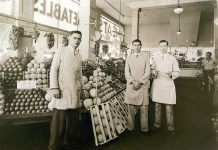While I was writing this column, I began to worry that it was
sounding a little too much like a college economics textbook, when
a song from my childhood came to mind. For our 8th Grade graduation
ceremony, we sang, “The Best Things in Life are Free”; little did I
know that my future studies would be in the Political Economy of
Natural Resources at UC Berkeley. At CAL we learned how we might
attempt to quantify those “best things in life that are free,” such
as fresh air, clean water, shade from an old oak tree in the
summer, or sunshine through a deciduous tree in the winter, and the
value of locally owned farms. Unless those “free things” have a
dollar value put on them, they are often excluded from economic
equations that drive our decisions. When they are not included in
economic calculations then their value is too often overlooked.
The subject of the last column was the price of lettuce, and
living in a free market society, the farmers are free to name their
own prices, and they do their own research to be competitive with
each other and retail outlets. However, like any market, whether it
is a market for lettuce, oil, or pork bellies, there are many
hidden benefits and costs that are often not included in the
economic equation. These hidden benefits, also known as positive
externalities of the market, and hidden costs, also known as
negative externalities of the market, are not easy to quantify.
At the Farmers’ Market, for instance, what is the value of the
fragrance of basil when you walk past Soda Rock Farm, or melons
from Ridgeview Farm, or roses from the Russian River Rose Company?
Or how do you quantify the sound of a live trombone playing, “When
the Saints Go Marching In,” on a day when news of Hurricane Katrina
was on everyone’s mind. What about the value of the familiar face,
with so much dignity and character, of a farmer like Nancy Skall,
or Sharon Vyborny, or Ed Miller, and so many others, who own and
sustain their Farmers’ Market. Then there is also the value of
keeping these farmers in business so we can maintain a diverse
agriculture in our community. These are just a few of the hidden
benefits, or positive externalities, of the Farmers’ Market, and by
that I mean that these benefits don’t have a dollar value on them;
they just come with the package. They are externalized from the
price that is set on the basil, or the melon, or the rose.
In a Farmers’ Market, and in any market for that matter, there
are the economics of supply and demand, and prices for goods based
on the cost of production, but it is the benefits that are not
included in the price of a peach or goat’s milk cheese that really
fascinate me. How do you quantify the pride you feel when you bring
a visitor to the Farmers’ Market, introducing them to farmers and
friends along the way, while at the same time purchasing fresh,
local, seasonal produce for meals at home? How do you put a dollar
value on a picture taken of a visitor surrounded by colorful market
umbrellas and all the hues of vibrant produce displayed under those
umbrellas? Once you begin to notice all these hidden benefits, then
the value of the market increases.
One of the biggest hidden benefits of the Farmers’ Market is how
much you as an individual reduce your carbon footprint by shopping
at the Farmers’ Market. It is a well researched fact that food
travels an average of 1,500 miles to get from the field to your
plate. This research was conducted by the Leopold Center for
Sustainable Agriculture in Ames, Iowa. When you consider the large
amount of food imported from Chile and China, then you can
understand why those “food miles” are so high.
The US Department of Agriculture found that our imports of
vegetables increased from 4% in 1970, to 12% in 2001, and imports
have continued to increase since then. Part of the reason we
continue to import food is because the cost of fossil fuels used in
long distance distribution are subsidized in many ways. We are only
able to import garlic from China, for instance, because of cheap
oil.
All that shipping relies heavily on fossil fuels, which are
being protected by a very expensive war. One of the unspoken
objectives of having our soldiers protecting trade routes around
the Persian Gulf or guarding oil fields is so trucks and tankers
can continue to ship food an average of 1,500 miles around the
world.
If you were to add some of the hidden costs, or negative
externalities, to the price of cheap food at a chain or big box
store, then that price would be much higher than food grown and
made locally. A Washington Post article in September 21, 2007 said
the war (in Iraq) was costing $720 million a day, or $500,000 a
minute; this was based on an analysis of the work of Nobel
Prize-winning economist Joseph E. Stiglitz and Harvard public
finance lecturer Linda J. Bilmes. With about 300 million people in
the US, that comes out to $2 dollars that each American paid, and
continues to pay, each day, mostly to protect oil.
Protecting oil is a huge cost, hidden in the artificially low
prices at Costco and large chain stores that depend on long
distance transportation. We can help reduce our dependence on war
and cheap oil by supporting local agriculture and by reducing food
miles back to what they were when our grandparents lived.
Mary Kelley is the manager of the Healdsburg Farmers’ Market.
The market is dormant for the winter.







